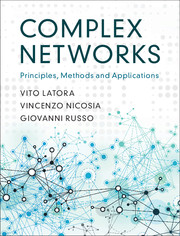Book contents
- Frontmatter
- Dedication
- Contents
- Preface
- Introduction
- Epigraph
- 1 Graphs and Graph Theory
- 2 Centrality Measures
- 3 Random Graphs
- 4 Small-World Networks
- 5 Generalised Random Graphs
- 6 Models of Growing Graphs
- 7 Degree Correlations
- 8 Cycles and Motifs
- 9 Community Structure
- 10 Weighted Networks
- Appendices
- References
- Author Index
- Index
Preface
Published online by Cambridge University Press: 11 October 2017
- Frontmatter
- Dedication
- Contents
- Preface
- Introduction
- Epigraph
- 1 Graphs and Graph Theory
- 2 Centrality Measures
- 3 Random Graphs
- 4 Small-World Networks
- 5 Generalised Random Graphs
- 6 Models of Growing Graphs
- 7 Degree Correlations
- 8 Cycles and Motifs
- 9 Community Structure
- 10 Weighted Networks
- Appendices
- References
- Author Index
- Index
Summary
Social systems, the human brain, the Internet and the World Wide Web are all examples of complex networks, i.e. systems composed of a large number of units interconnected through highly non-trivial patterns of interactions. This book is an introduction to the beautiful and multidisciplinary world of complex networks. The readers of the book will be exposed to the fundamental principles, methods and applications of a novel discipline: network science. They will learn how to characterise the architecture of a network and model its growth, and will uncover the principles common to networks from different fields.
The book covers a large variety of topics including elements of graph theory, social networks and centrality measures, random graphs, small-world and scale-free networks, models of growing graphs and degree–degree correlations, as well as more advanced topics such as motif analysis, community structure and weighted networks. Each chapter presents its main ideas together with the related mathematical definitions, models and algorithms, and makes extensive use of network data sets to explore these ideas.
The book contains several practical applications that range from determining the role of an individual in a social network or the importance of a player in a football team, to identifying the sub-areas of a nervous systems or understanding correlations between stocks in a financial market.
Thanks to its colloquial style, the extensive use of examples and the accompanying software tools and network data sets, this book is the ideal university-level textbook for a first module on complex networks. It can also be used as a comprehensive reference for researchers in mathematics, physics, engineering, biology and social sciences, or as a historical introduction to the main findings of one of the most active interdisciplinary research fields of the moment.
This book is fundamentally on the structure of complex networks, and we hope it will be followed soon by a second book on the different types of dynamical processes that can take place over a complex network.
Information
- Type
- Chapter
- Information
- Complex NetworksPrinciples, Methods and Applications, pp. xiPublisher: Cambridge University PressPrint publication year: 2017
